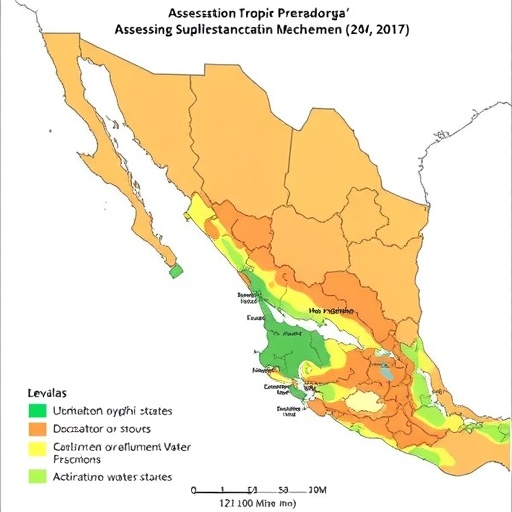In recent scientific inquiries, the dynamics of freshwater ecosystems have gained significant traction as researchers attempt to decode the intricate relationships and interactions occurring within them. A pivotal study led by Espinosa-Rodríguez, Martínez-Vargas, and De la Luz-Vázquez, as reported in their paper published in “Environmental Monitoring and Assessment,” delves into the application of zooplankton-based trophic state indices as a means of assessing the health and quality of reservoirs and lakes in central Mexico. Through their comprehensive analysis, the authors shed light on crucial ecological indicators that could enhance our understanding of limnological conditions in this vital region.
The research addresses a pressing need to establish reliable environmental indicators that reflect the biological state of aquatic systems. Trophic state indices (TSI) play an essential role in this context, as they provide a quantitative framework for classifying water bodies based on nutrient concentrations and biological productivity. However, traditional methods primarily rely on physical and chemical analyses, which may overlook the significant ecological impacts driven by the biological components of the ecosystem. This study proposes a novel approach that integrates zooplankton assessments into the conventional TSI framework, offering a fresh perspective on evaluating the ecological state of water bodies.
Central Mexico is home to a variety of reservoirs and lakes, each with distinct ecological characteristics influenced by anthropogenic activities and natural factors. The authors meticulously selected several study sites reflecting varied levels of nutrient enrichment and disturbances to evaluate the applicability of zooplankton-based trophic state indices. By sampling zooplankton populations, the researchers aimed to correlate these biological communities with traditional chemical parameters, thereby enhancing the predictive power and ecological relevance of TSI methodologies across different freshwater environments.
A detailed examination of the zooplankton assemblages revealed variations in species composition and abundance correlating to the trophic conditions of the studied water bodies. The findings underscore the significance of specific zooplankton taxa, indicating their potential as bioindicators for assessing the ecological health of freshwater systems. This is particularly relevant in urbanized and agricultural landscapes where lakes and reservoirs face an array of stressors, including nutrient loading and habitat degradation caused by human activities. By leveraging these biological indicators alongside traditional assessments, the researchers argue that management of freshwater ecosystems could be more effective and contextually relevant.
The study results resonate with ecological paradigms that emphasize the interconnectedness of biotic communities within aquatic ecosystems. While nutrient concentrations often represent snapshots of chemical states, the biological responses captured through zooplankton metrics provide a more nuanced understanding of the ongoing ecological processes. As productivity surges due to increased nutrient loads, shifts in zooplankton community structures can serve as early warning signals, alerting policymakers and environmental managers to potential adverse effects on these ecosystems.
Concurrently, the study discusses challenges posed by the management and conservation of freshwater resources in an era characterized by climate change and intensified human pressures. Traditional assessment techniques may not suffice in capturing the rapid environmental shifts occurring in freshwater habitats. Therefore, incorporating biological assessments, such as those based on zooplankton dynamics, may drastically enhance our ability to gauge current conditions and predict future responses to ongoing and emerging stressors.
Ecologists have long been aware of the intricate relationships governing aquatic ecosystems, from nutrient cycling to food web dynamics. This innovative research not only revitalizes the concept of trophic state indices but also emphasizes the necessity of including biological metrics in environmental assessments. As global awareness of freshwater conservation grows, bridging the knowledge gap between chemical assessments and biological indicators becomes paramount. In doing so, effective and sustainable management practices can emerge, promoting the resilience of aquatic life in changing environments.
Moreover, the implications of this study are far-reaching, extending beyond the immediate context of central Mexico. The adoption of zooplankton-based metrics offers a template for similar assessments in diverse ecosystems worldwide. By enhancing conventional monitoring techniques, researchers can foster a deeper understanding of global freshwater systems and their responses to changing climatic conditions.
In conclusion, the research conducted by Espinosa-Rodríguez, Martínez-Vargas, and De la Luz-Vázquez is a testament to the evolving landscape of aquatic ecology. It highlights the importance of integrating biological indicators into standard monitoring protocols to enhance the accuracy and relevance of assessments. As scientists continue to explore the delicate balance of freshwater ecosystems, findings such as these underscore the need for innovative approaches in gauging the health of our lakes and reservoirs. The road ahead is ripe with opportunities for research and application, ensuring that our freshwater resources remain viable for generations to come.
The authors have opened a vital dialogue on the intersection of zooplankton dynamics and trophic state indices, underlining the necessity for adaptive management strategies in ecology. As academia, policy, and public discourse increasingly converge on environmental issues, this research paves the way for more informed conservation efforts aimed at protecting invaluable aquatic habitats across the globe.
Given these compelling findings, it is imperative for researchers, regulators, and conservationists to consider biological assessments as fundamental components of ecological monitoring and management. The pathway to sustainable ecosystems is clear: integrating ecological indicators brings us closer to understanding and preserving the delicate balance of life in our water bodies.
Subject of Research: Zooplankton-based trophic state indices assessment of reservoirs and lakes in Central Mexico.
Article Title: Zooplankton-based trophic state indices assessment of reservoirs and lakes in Central Mexico.
Article References:
Espinosa-Rodríguez, C.A., Martínez-Vargas, L.Á., De la Luz-Vázquez, K. et al. Zooplankton-based trophic state indices assessment of reservoirs and lakes in Central Mexico.
Environ Monit Assess 197, 1176 (2025). https://doi.org/10.1007/s10661-025-14599-x
Image Credits: AI Generated
DOI:
Keywords: Zooplankton, trophic state indices, freshwater ecosystems, ecological health, environmental assessments.




